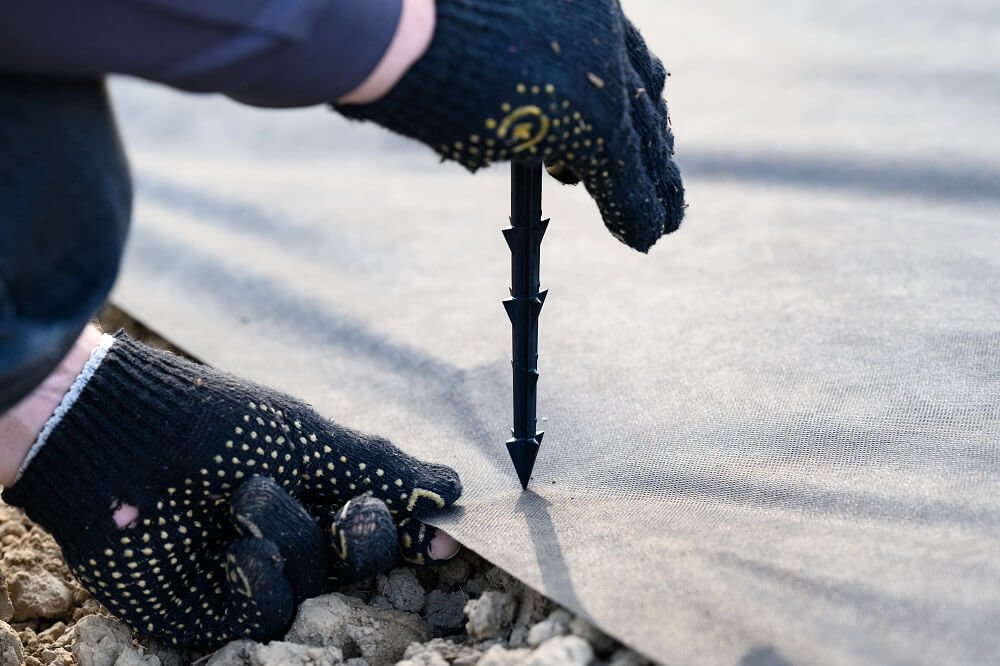
Use of agro-textiles under stones brings with it a number of benefits that can significantly increase the functionality and aesthetic value of a garden. First and foremost agro-textile under stones effectively protects against weed growth, which is particularly important in ornamental beds. This allows us to reduce the use of chemicals and the time spent on care. Another benefit is the protection of the soil from erosion. The layers of material prevent the soil from being washed away during rain, ensuring stability of the ground and better conditions for the plants.
But that’s not all — the use of agro-textiles under stones also greatly improves the aesthetics of the garden. If chosen well, it is not visible under a layer of stones, ensuring a neat and tidy appearance to the space. If you are wondering, which agro-textile will be best under the stones, it is worth paying attention to the thickness and permeability of the material. A robust yet permeable agro-textile allows water to flow freely while eliminating the risk of stagnation. It is worth investing in a quality product to enjoy its benefits for many years.
Various types of agro-textilewhich can be used under stones and their choice depends on the specific needs of the garden. Agro-textiles vary in thickness, colour and permeability. The most popular are black and brown agro-textiles, which are effective in blocking light from entering the soil and preventing weed growth. It is also worth paying attention to the thickness of the product — thicker agro-textiles are more durable and provide better protection against soil erosion.
Deciding, which agro-textile will be the best under the stones, you should also be guided by parameters such as tear strength and air permeability. There are also biodegradable nonwoven fabrics, which decompose over time without having a negative impact on the environment. By investing in the right type of nonwoven fabric for the stones, you can significantly increase the attractiveness and functionality of your garden, while minimising the need for maintenance.
When starting work, it is useful to know, how to lay agro-textile under stones and what rules to follow to make the result long-lasting and aesthetically pleasing. First of all, start by preparing the ground — remove all weeds, stones and other obstacles. Next, level the surface of the soil, ensuring that it is sufficiently moist. Remember that the application of agro-textiles on dry soil can make it difficult to spread it evenly. Spread the agro-textile over the entire area, leaving small overlaps at the joints to prevent weeds from entering through the gaps.
The next step is to attach agro-textiles using special pins, placing them approximately every 30–50 cm. Make sure that the material is well tensioned and adheres to the soil. Once the fleece is securely fastened, you can start laying the stones. Spread them out evenly, making sure that the entire surface of the agro-textile is covered. To achieve a natural effect, stones of different sizes and shapes can be used. Done properly, this will ensure that weed growth is reduced and the ground is stable.
When laying agro-textile under stones, some mistakes are often made that can affect the durability and effectiveness of this solution. One of the most common problems is inadequate site preparation. The removal of any weeds, stones or other obstacles is key, as the elements left behind can damage the agro-textile. Another common mistake with laying agro-fibre is its careless spreading. If the agro-textile is not stretched evenly and there are no proper overlaps at the joints, weeds can get through the gaps.
Lack of proper fixing is another common problem. Using too few pins or pegs can cause the agro-textile to move, which not only reduces the aesthetics but also its functionality. It is important to use pins every 30–50 cm to keep the material stable. You should also avoid using low-quality agro-textile, which can wear out quickly and will not effectively protect against weeds. Before you start work, it is worth checking carefully, how to lay agro-textile under stones and which materials and techniques will be most suitable for your garden. By following these tips, you can avoid mistakes and enjoy an aesthetically pleasing and functional garden for a long time.